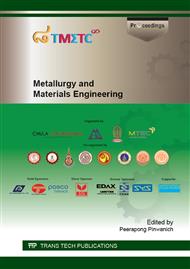p.151
p.156
p.161
p.167
p.172
p.177
p.185
p.190
p.195
Determination of Stress-Strain Curve of Dual Phase Steel by Nanoindentation Technique
Abstract:
The advanced high strength (AHS) steels, for example, dual phase (DP) steels, transformation induced plasticity (TRIP) steels and complex (CP) steels principally exhibit multiphase microstructure features. Thus, mechanical behavior of the constituent phases significantly affects the resulting overall properties of such AHS steels. Novel material characterization techniques on micro- and nano-scale have become greatly more important. In this work, stress-strain response of the DP steel grade 1000 was determined by using the Nanoindentation testing. The DP steel showed the microstructure containing finely distributed martensite islands of about 50% phase fraction in the ferritic matrix. The nano-hardness measurements were firstly performed on each individual phase of the examined steel. In parallel, finite element (FE) simulations of the corresponding nano-indentation tests were carried out. Flow curves of the single ferritic and martensitic phases were defined according to a dislocation based theory. Afterwards, the load and penetration depth curves resulted from the experiments and simulations were compared. By this manner, the proper stress-strain responses of both phases were identified and verified. Finally, the effective stress-strain curve of the investigated DP steel could be determined by using 2D representative volume element (RVE) model.
Info:
Periodical:
Pages:
195-201
Citation:
Online since:
July 2015
Authors:
Keywords:
Price:
Сopyright:
© 2015 Trans Tech Publications Ltd. All Rights Reserved
Share:
Citation:


